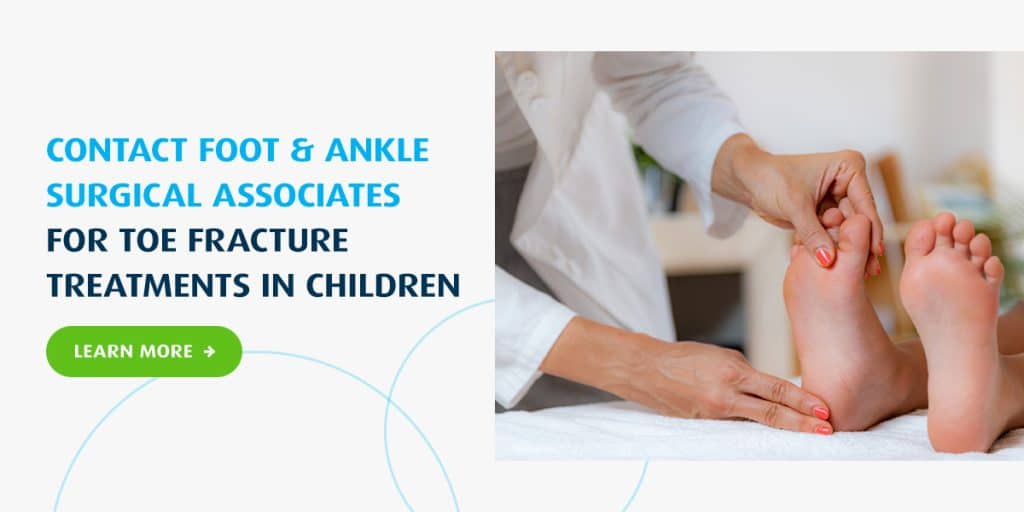If your child is complaining about pain in their foot, you may be worried about a toe fracture. Limping, swelling and other signs of injury or pain could indicate that your child has broken their toe. Once a toe fracture is diagnosed, your child’s doctor will give you different methods to care for your child at home, including medications, support devices or splints.
What Is a Toe Fracture?
Toe fractures or broken toes are when one or more bones in the foot break after an injury. A child can break their toe in many ways, including dropping something on their foot, stubbing their toe or playing a sport involving their feet. While you can help your child avoid a broken toe as much as possible, sometimes it’s unavoidable. One of the most common child fractures is a fracture of the metatarsals, which is a break in bones toward the front of the foot.
Look for the following signs and symptoms in your child to identify a toe fracture:
- Pain and redness
- Swelling and bruising
- A toe bent at an unnatural or unusual angle
- Inability to put weight on the toe
- Inability to bend or move the toe
- Sensations of tingling or numbness in the toe
If you notice any of these symptoms in your child, take them for evaluation as soon as possible. A medical professional can help relieve your child’s pain and ensure the bone sets correctly.
How Is a Toe Fracture Diagnosed?
Your child’s doctor will evaluate your child’s toe and ask questions about the injury, such as how it happened and what symptoms your child is experiencing. Sometimes questions and a visual inspection are all your child may need, but your doctor may recommend additional testing, including:
- X-rays: An X-ray shows the break in more detail so your child’s doctor can determine where exactly the break occurred. An X-ray can help inform treatment by assessing the severity of the fracture.
- MRIs: An MRI is a more detailed imaging test than an X-ray. A doctor usually orders one if they expect ligament damage or a stress fracture. Your child may need to take contrast liquid before their MRI to help their injury appear better on the imaging. Tell the doctor if your child has ever had a reaction to contrast liquid or if they have any metal in their body since metal can cause severe injury in an MRI.
After the test results, your child’s doctor will explain their findings to you and what that means for treatment. The severity of the break will determine the level of treatment required for healing.
How to Treat a Broken Toe
Your doctor will recommend different treatments based on the evaluation results. Treatment can range from noninvasive to invasive, and your child’s doctor will walk you through the process. Potential treatments for a broken toe include:
- A splint or bandage to add support while keeping the toe in the correct position.
- Support devices to assist in walking while the broken toe is healing, including crutches, a cane or a walking boot.
- Medications to help prevent infections and reduce pain during the healing process.
- A closed reduction procedure that moves the bone into the correct position without surgery.
- Surgery if the break is severe, which can include placing pins, wires or other materials to keep the bones in place while it heals.
Your child’s doctor will determine what to do for a broken toe based on the severity of the break. A more severe break may need surgery, but a mild break may only require a splint and medication to help manage symptoms and assist in healing.
How to Help Your Child Through a Broken Toe
There’s nothing worse than seeing their child in pain. A broken toe can be painful, especially when it’s a severe break. A broken toe can take between four to six weeks to heal, potentially longer if surgery is involved. You can use the tips below to help support your child so they can heal and reduce their pain as quickly as possible.
1. Ensure Your Child Gets Enough Rest

Getting enough rest is essential to encourage healing whenever you break a bone. If your child isn’t resting enough, they could put too much pressure on the toe, worsening the injury.
Your child should pause activities that could worsen the break, including playing sports or excessive walking. Encourage your child to use crutches or other support devices while walking to help prevent excessive pressure on the break. The more rest your child gets, the sooner they’ll be able to return to normal activities.
2. Use Ice
A broken toe can cause plenty of swelling and inflammation, which could cause more pain by putting pressure on the break and surrounding joints. Ice can help alleviate symptoms significantly, helping reduce swelling and inflammation.
Apply ice to your child’s broken toe for 15 to 20 minutes each hour until the swelling and pain lessen. You can use an ice pack or make one at home using a bag and crushed ice. Cover the spot with a towel to avoid direct contact, which can cause more pain and sensitivity from the intense cold.
3. Encourage Elevation
Elevation can also help with swelling and pain by drawing blood away from the broken toe. Have your child keep their foot above their heart as often as possible using pillows or other materials to help the foot comfortably rest as high as necessary.
4. Keep Up With Medication Schedules
Your child’s doctor may prescribe medication for pain management, which may or may not include antibiotics to treat or prevent an infection. Follow the medication schedule as prescribed, which typically includes giving antibiotics until the medication is gone and pain medication as needed.
If your child’s doctor hasn’t prescribed medication, ask if over-the-counter medicines — such as Tylenol or another pain and inflammation treatment — are safe for your child.
Contact Foot & Ankle Surgical Associates for Toe Fracture Treatments in Children
A broken toe is painful, especially when watching your child experience it. Foot & Ankle Surgical Associates can help you find an effective treatment for your child’s broken toe, including surgery for severe breaks. We provide the best care possible to help improve quality of life, which includes repairing broken toes as soon as possible, so your child can resume their regular activities.
Our doctors work with you and your child as a team and walk you through treatment and recovery. We’ll help your child reach better physical health so they can enjoy everything life offers — contact us today to learn more about our treatment options and how we can help.




